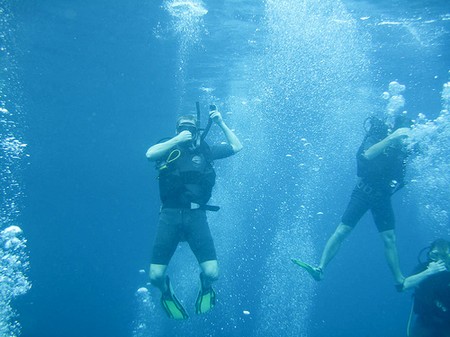Ear problems
Many people say that they cannot learn to dive because they get pain in their ears when they swim underwater. This is not surprising because if you don’t know how to clear your ears, whether you’re scuba diving or simply swimming underwater, you will be in danger of rupturing an eardrum – a very painful experience!
How the ear works
Ears have an outer section – the part we can see consists of a fleshy flap called the pinna, which gathers sound, and a hole that leads to the eardrum. The eardrum is exactly that -a membrane of tightly stretched tissue like a drum. This tissue vibrates as it contacts sound waves that move through the air.
The vibrations are transmitted via a set of tiny bones to a vibration-sensitive window in the cochlea – the complex organ that holds the aural nerve and forms the inner ear.
The inner ear also contains semi-circular canals filled with fluid that enable us to recognise how our body is positioned, whether horizontal or vertical.
The part between the outer ear and the inner ear is known as the middle ear. It is normally full of air at the same pressure as the air around us. It is connected to the throat by the Eustachian tube, but to stop any liquid from entering our ears when we drink, the Eustachian tube has a constriction at its lower end.
Water pressure
When you go underwater, water enters the outer ear cavities and presses on the eardrums – you can feel this pressure.
Because the air on the other side of the eardrum is at the pressure it was when you breathed in before your dive, there is an imbalance and the eardrums are distorted. You need to redress this balance before the pain becomes intense and the eardrums rupture.
A diver breathes air from a regulator at the same pressure as the surrounding water. But this air doesn’t enter the middle ear from the mouth via the Eustachian tube because of the constriction in the tube.
To clear the constriction, pinch your nose and blow gently. You will force air at the same pressure as the water past the constriction and into the middle ear. You will hear your ears ‘pop’ and the discomfort will pass immediately.
The important thing is getting the inhaled air past the constriction. Some people can do that by wiggling their jaw or simply by swallowing to open the constriction momentarily.
As long as your Eustachian tube is not blocked – perhaps because you have a head cold – pinching your nose and blowing gently against the pinch should always clear the your ears without difficulty.
Make it a habit
Divers usually clear their ears without giving it a second thought. It becomes a natural thing to do. You should do it the moment you are aware of the pressure and long before there is any pain.
Going up and down
On the ascent, the air in the Eustachian tubes expands and forces its way past the constriction, just as any fluid in your middle ear drains naturally into your throat cavity. You shouldn’t notice anything.
On the way down to a dive, you should never continue to descend if your ears hurt. If that happens, go shallower and try again.
